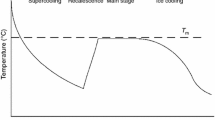Abstract
The behaviour of one drop impinging on a hot surface by varying the surface temperature, the drop velocity and the position of the surface (horizontal and a inclined 45°) both at a temperature below and above the Leidenfrost temperature has been experimentally evaluated, estimating the temperature at which the drop rebounds. A large influence on the drop velocity has been evidenced. The inclination of the surface decreases the critical value of the temperature above which the surface is not rewetted.






Similar content being viewed by others
Abbreviations
- d :
-
drop falling height, mm
- D :
-
drop diameter, m
- Re :
-
Reynolds number ρuD/μ, –
- u :
-
drop velocity, m/s
- T :
-
temperature, °C
- We :
-
Weber number Dρu 2/σ, –
- μ:
-
dynamic viscosity, kg/m s
- ρ :
-
density, kg/m3
- σ :
-
surface tension, kg
- Leid:
-
Leidenfrost
- w:
-
wall
References
Celata GP, Cumo M, Mariani A (2002) Rewetting of hot surfaces by droplet impingement. In: Paper B1 presented to European two-phase flow group meeting, Stockholm, 11–13 June
Castiglia F, Giardina M, Oliveri E (2001) Modelling the rewetting of hot tubes, In: Proceedings of 19th UIT National Heat Transfer Conference, 331
Bernardin JD, Mudawar I (1999) The Leidenfrost point: experimental study and assessment of existing models. Trans ASME 121:894
Nagai N, Nishio S (1996) Leidenfrost temperature on an extremely smooth surface. Exp Therm Fluid Sci 12:373
Testa P, Nicotra L (1986) Influence of pressure on the Leidenfrost temperature and on extracted heat fluxes in the transient mode and low pressure. Trans ASME 108:916
Wennerstrom H, Frid W, Blomstrand J (1997) The effect of surfactants on the Leidenfrost temperature. In: Paper C6 presented to European two-phase flow group meeting, Brussels, 6–7 June
Eckert ERG, Drake RM Jr (1972) Analysis of heat and mass transfer. McGraw-Hill, New York
Berenson PJ (1961) Film boiling heat transfer from a horizontal surface. ASME J Heat Transfer 83:351
Baumeister KJ, Simon FF (1973) Leidenfrost temperature—its correlation for liquid metals, cryogenics, hydrocarbons and water. ASME J Heat Transfer 95:166
Schroeder-Richter D, Bartsch G (1990) The Leidenfrost phenomenon caused by a thermo-mechanical effect of transition boiling: a revisited problem of non-equilibrium thermomechanics. In: Fundamental of phase change: boiling and condensation, ASME
Author information
Authors and Affiliations
Corresponding author
Rights and permissions
About this article
Cite this article
Celata, G.P., Cumo, M., Mariani, A. et al. Visualization of the impact of water drops on a hot surface: effect of drop velocity and surface inclination. Heat Mass Transfer 42, 885–890 (2006). https://doi.org/10.1007/s00231-006-0139-1
Received:
Accepted:
Published:
Issue Date:
DOI: https://doi.org/10.1007/s00231-006-0139-1




